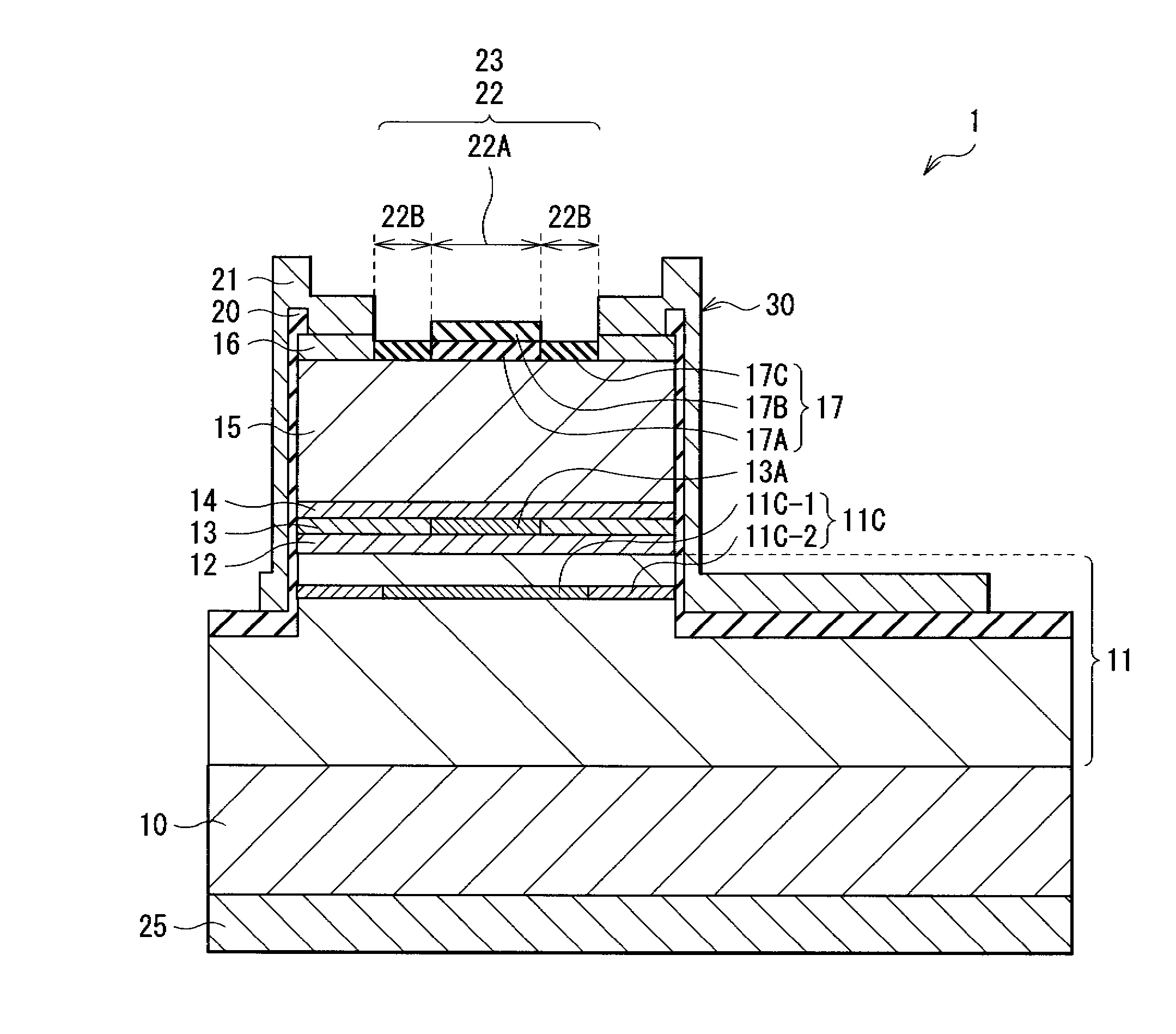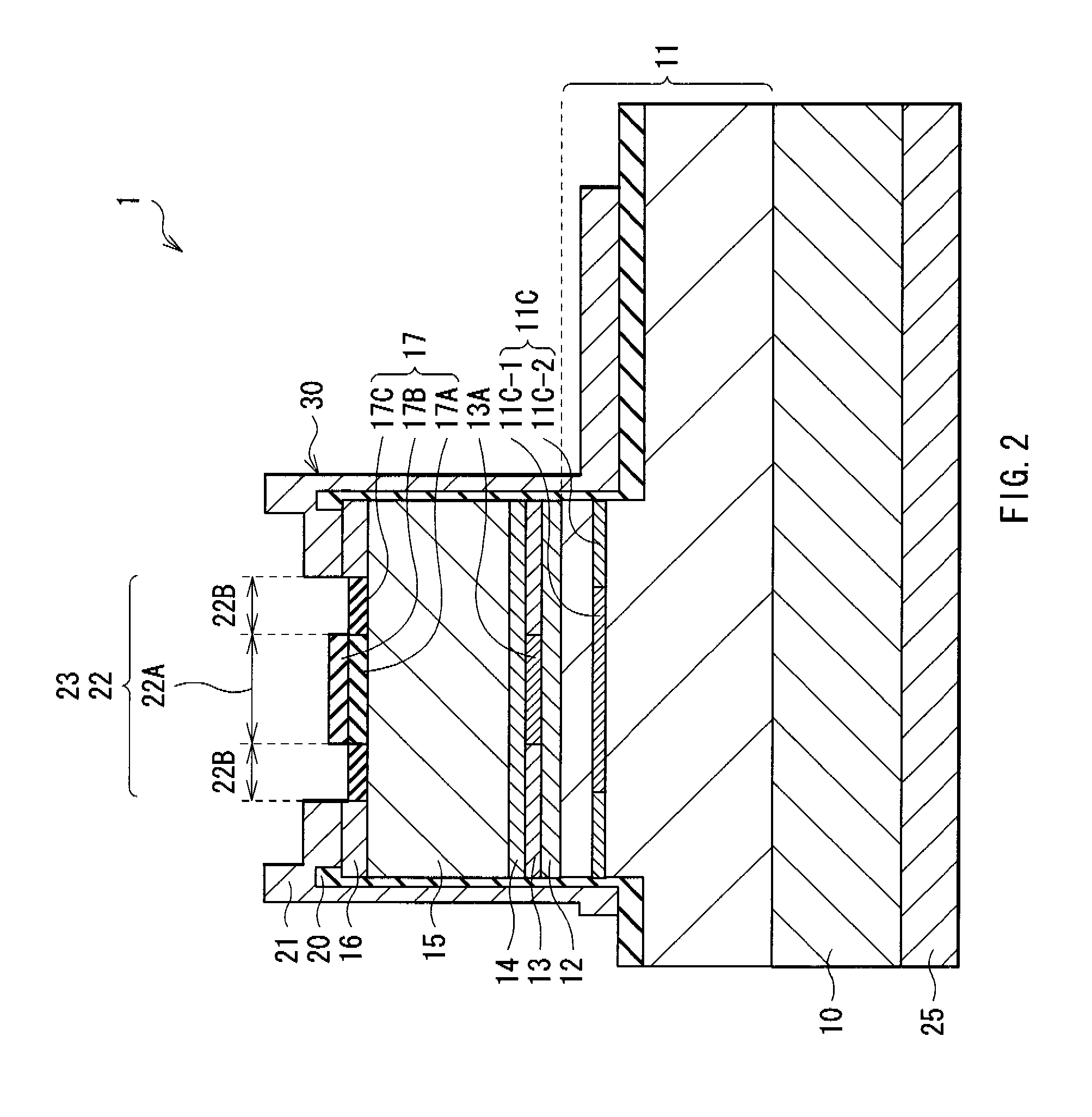Vertical cavity surface emitting laser
a laser and vertical cavity technology, applied in the direction of laser details, semiconductor lasers, electrical devices, etc., can solve the problems of difficult to manufacture such a special substrate, polarization direction may not be stabilized in one direction, and the price of gradient substrates is greatly increased. , to achieve the effect of easy and inexpensive manufacturing, and easy and inexpensive manufacturing
- Summary
- Abstract
- Description
- Claims
- Application Information
AI Technical Summary
Benefits of technology
Problems solved by technology
Method used
Image
Examples
first embodiment
[0047]FIG. 1 shows a perspective view of a VCSEL 1 according to an embodiment of the invention. FIG. 2 shows a cross sectional structure taken along arrows A-A of the VCSEL 1 of FIG. 1. FIG. 3 shows a cross sectional structure taken along arrows B-B of the VCSEL 1 of FIG. 1. FIG. 4 shows a top face structure of a mesa portion 30 of FIG. 1. FIG. 5 shows a cross sectional structure of a current confinement layer 11C of FIG. 2. FIG. 6A shows a cross sectional structure of a transverse mode adjustment layer 17 and the vicinity thereof. FIG. 6B shows a reflectance distribution of the transverse mode adjustment layer 17 of FIG. 2.
[0048] The VCSEL 1 has a laser structure portion in which a lower DBR mirror layer 11 (first multilayer film reflector), a lower cladding layer 12, an active layer 13, an upper cladding layer 14, an upper DBR mirror layer 15 (second multilayer film reflector), a p-side contact layer 16, and the transverse mode adjustment layer 17 are layered in this order on one...
second embodiment
[0093]FIGS. 10A and 10B respectively show a structure of a transverse mode adjustment layer 27 and the vicinity thereof of a VCSEL 2 according to a second embodiment, and a reflectance distribution of the transverse mode adjustment layer 27. The VCSEL 2 differs from the foregoing embodiment in that only the reflectance of the peripheral region 22B is lowered than that of the central region 22A by the transverse mode adjustment layer 27 composed of a forth adjustment layer 27A provided in the central region 22A of the light emitting window 22 and a fifth adjustment layer 27B provided in the peripheral region 22B thereof. Descriptions will be given of the fourth adjustment layer 27A and the fifth adjustment layer 27B. In FIGS. 10A and 10B, the case that the transverse mode adjustment layer 27 is convex is shown. However, the shape of the transverse mode adjustment layer 27 may be concave depending on the magnitude relation of thickness between the forth adjustment layer 27A and the fi...
third embodiment
[0098]FIGS. 11A and 11B respectively show a structure of a transverse mode adjustment layer 47 and the vicinity thereof of a VCSEL 4 according to a third embodiment, and a reflectance distribution of the transverse mode adjustment layer 47. The VCSEL 4 differs from the foregoing embodiments in that only reflectance of the peripheral region 22B is lowered than that of the central region 22A by the transverse mode adjustment layer 47 composed of a tenth adjustment layer 47A and an eleventh adjustment layer 47B provided in the central region 22A of the light emitting window 22 and a twelfth adjustment layer 47C and the thirteenth adjustment layer 47D provided in the peripheral region 22B thereof. Descriptions will be given of these adjustment layers 47A, 47B, 47C, and 47D. In FIGS. 11A and 11B, the case that the transverse mode adjustment layer 47 is convex is shown. However, the shape of the transverse mode adjustment layer 47 may be concave depending on the magnitude relation of thic...
PUM
 Login to View More
Login to View More Abstract
Description
Claims
Application Information
 Login to View More
Login to View More - R&D
- Intellectual Property
- Life Sciences
- Materials
- Tech Scout
- Unparalleled Data Quality
- Higher Quality Content
- 60% Fewer Hallucinations
Browse by: Latest US Patents, China's latest patents, Technical Efficacy Thesaurus, Application Domain, Technology Topic, Popular Technical Reports.
© 2025 PatSnap. All rights reserved.Legal|Privacy policy|Modern Slavery Act Transparency Statement|Sitemap|About US| Contact US: help@patsnap.com



